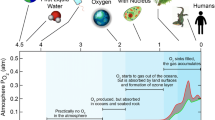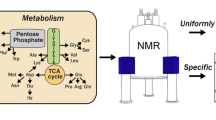Abstract
We report the 1H, 13C, and 15N chemical shift assignments of both oxidized and reduced forms of an abundant periplasmic c-type cytochrome, designated ApcA, isolated from the acidophilic gram-negative facultatively anaerobic metal-reducing alphaproteobacterium Acidiphilium cryptum. These resonance assignments prove that ApcA is a monoheme cytochrome c 2 and the product of the Acry_2099 gene. An absence of resonance peaks in the NMR spectra for the 21N-terminal residues suggests that a predicted N-terminal signal sequence is cleaved. We also describe the preparation and purification of the protein in labeled form from laboratory cultures of A. cryptum growing on 13C- and 15N- labeled substrates.


Similar content being viewed by others
References
Benning MM, Meyer TE, Holden HM (1996) Molecular structure of a high potential cytochrome c 2 isolated from Rhodopila globiformis. Arch Biochem Biophys 333:338–348
Bertini I, Cavallaro G, Rosato A (2006) Cytochrome c, occurrence and functions. Chem Rev 106:90–115
Cort JR, Selan U, Schulte A, Kennedy MA, Dahl C (2008) Allochromatium vinosum DsrC: solution-state NMR structure, redox properties and interaction with DsrEFH, a protein essential for purple sulfur bacterial sulfur oxidation. J Mol Biol 382:692–707
Goddard TD, Kneller DG (2008) SPARKY 3. University of California, San Francisco
Kahre N, Lovelace DM, Eggleston CM, Swenson M, Magnuson TS (2006) Redox-linked conformation change and electron transfer between monoheme c-type cytochromes and oxides. Geochim Cosmochim Acta 70:4332–4342
Kiefer F, Arnold K, Künzli M, Bordoli L, Schwede T (2009) The SWISS-MODEL repository and associated resources. Nucleic Acids Res 37:D387–D392
Kusel K, Dorsch T, Acker G, Stackebrandt E (1999) Microbial reduction of Fe(III) in acidic sediments: isolation of Acidiphilium cryptum JF-5 capable of coupling the reduction of Fe(III) to the oxidation of glucose. Appl Env Microbiol 65:3633–3640
Marion D (1994) Nuclear magnetic resonance studies of cytochromes c in solution. Biochimie 76:631–640
Methé BA, Nelson KE, Eisen JA, Paulsen IT, Nelson W, Heidelberg JF, Wu D, Wu M, Ward N, Beanan MJ, Dodson RJ, Madupu R, Brinkac LM, Daugherty SC, DeBoy RT, Durkin AS, Gwinn M, Kolonay JF, Sullivan SA, Haft DH, Selengut J, Davidsen TM, Zafar N, White O, Tran B, Romero C, Forberger HA, Weidman J, Khouri H, Feldblyum TV, Utterback TR, Van Aken SE, Lovley DR, Fraser CM (2003) Genome of Geobacter sulfurreducens: metal reduction in subsurface environments. Science 302:1967–1969
Neri D, Szyperski T, Otting G, Senn H, Wüthrich K (1989) Stereospecific nuclear magnetic resonance assignments of the methyl groups of valine and leucine in the DNA-binding domain of the 434 repressor by biosynthetically directed fractional 13C labelling. Biochemistry 28:7510–7516
Acknowledgments
600 and 750 MHz NMR spectra were acquired in the Environmental Molecular Sciences Laboratory (EMSL), a national scientific user facility sponsored by the Department of Energy’s Office of Biological and Environmental Research and located at Pacific Northwest National Laboratory. Research was supported by the Department of Energy (Grant DE-FG02-06ER15824 to TSM) and the National Science Foundation (Grant 0434023 to TSM).
Author information
Authors and Affiliations
Corresponding author
Electronic supplementary material
Below is the link to the electronic supplementary material.
Fig. S1
600 MHz 1H–13C HSQC spectra recorded in D2O showing the aliphatic regions for oxidized (top) and reduced (bottom) ApcA at pH 5.0. Spectra were recorded at 293 K with 192 or 256 complex points in the indirect dimension and 1024 complex points acquired in the direct dimension. The spectral width of the 13C dimension was 80 ppm in both spectra. (EPS 7622 kb)
Rights and permissions
About this article
Cite this article
Cort, J.R., Swenson, M.W. & Magnuson, T.S. 1H, 13C, and 15N backbone, side-chain, and heme chemical shift assignments for oxidized and reduced forms of the monoheme c-type cytochrome ApcA isolated from the acidophilic metal-reducing bacterium Acidiphilium cryptum . Biomol NMR Assign 5, 89–92 (2011). https://doi.org/10.1007/s12104-010-9274-1
Received:
Accepted:
Published:
Issue Date:
DOI: https://doi.org/10.1007/s12104-010-9274-1




